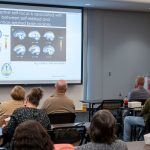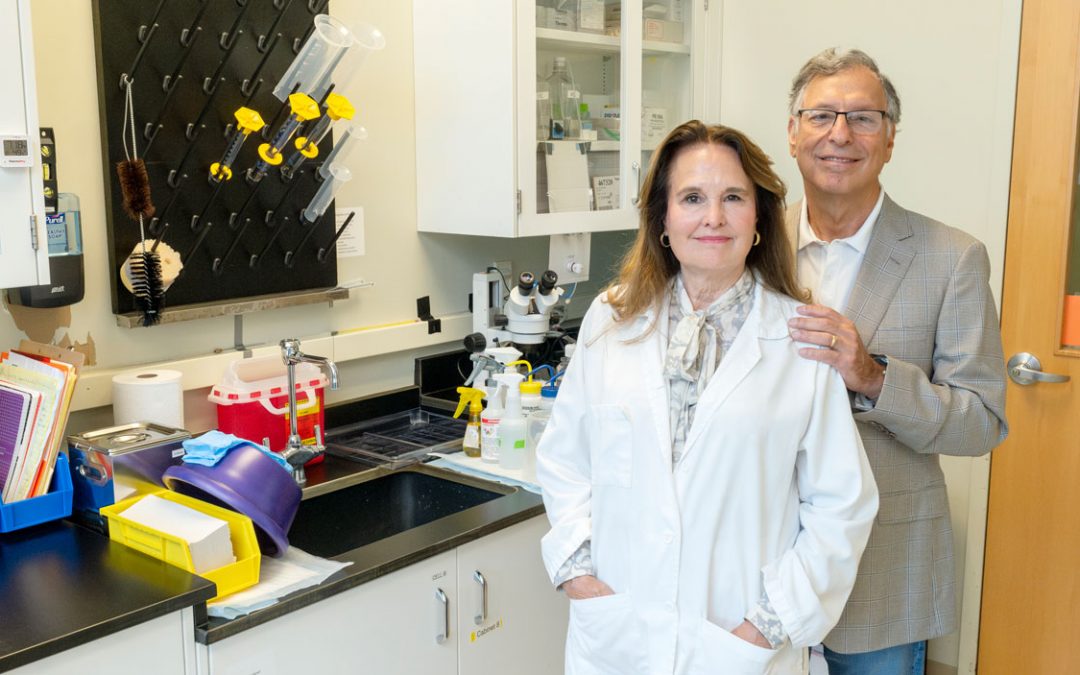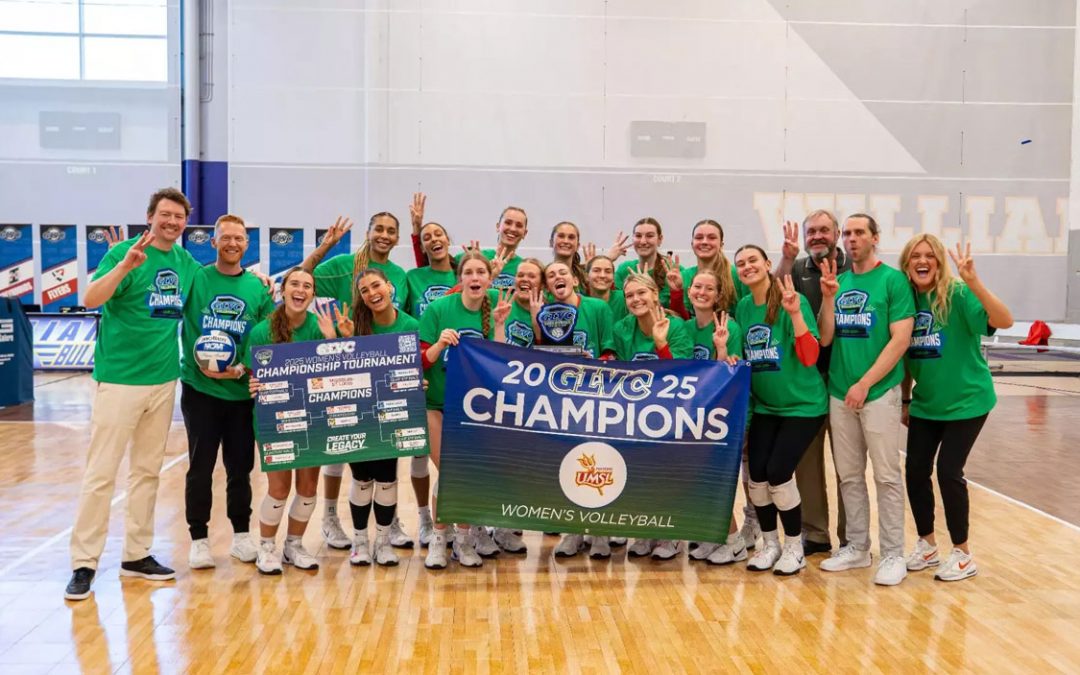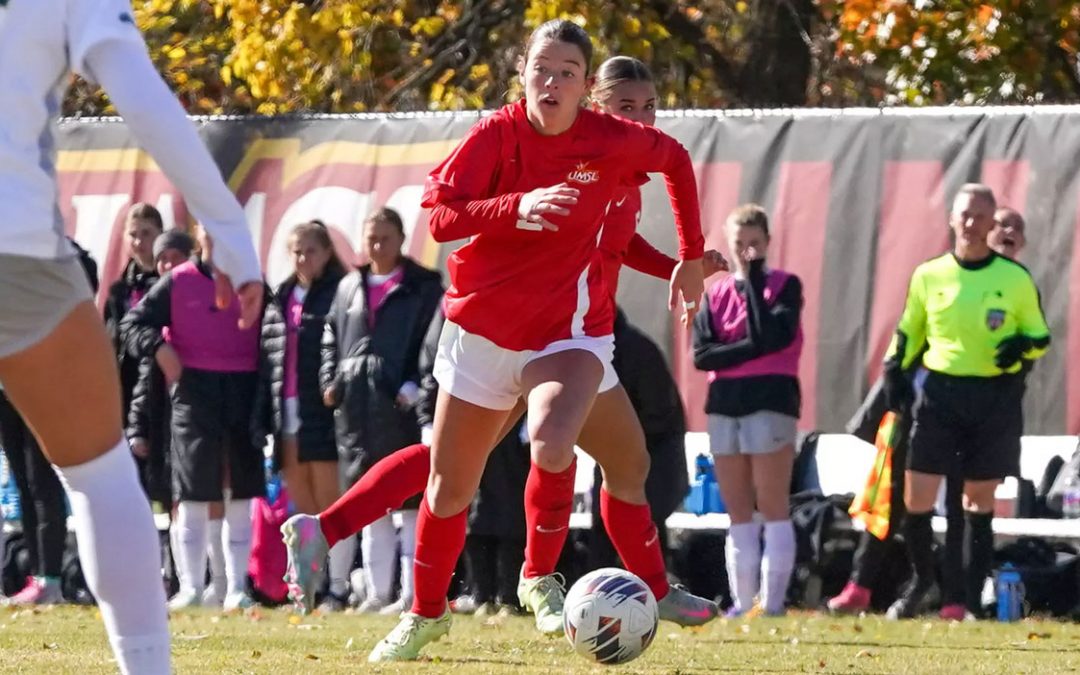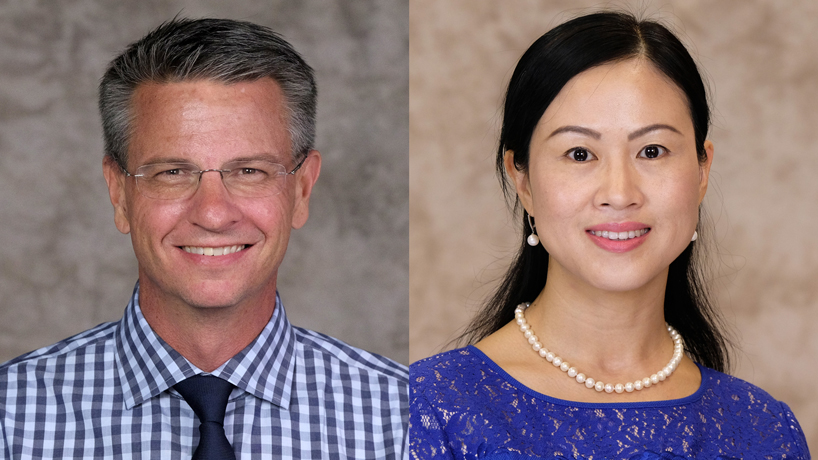
Robert Paul (at left), a member of the Department of Psychological Sciences and the director of the Missouri Institute of Mental Health, and Gaiyan Zhang, part of the faculty in the Department of Finance and Legal Studies, have been named Curators’ Distinguished Professors. (Photos by August Jennewein)
University of Missouri–St. Louis Professor Robert Paul has worked throughout his career to increase the collective understanding of how subcortical brain systems impact cognitive and affective behavior.
Paul, who serves as director of the UMSL’s Missouri Institute of Mental Health and is a member of the faculty in the Department of Psychological Sciences, is also part of the leadership team for the International NeuroHIV Cure Consortium. Members of the consortium work across a diverse array of fields and deploy cutting-edge techniques to discover the mechanisms and clinical consequences of persistent HIV infection in the brain after otherwise successful use of antiretroviral therapy.
Professor Gaiyan Zhang, a member of the Department of Finance and Legal Studies, meanwhile, has gained international recognition as a leading researcher on financial risk and contagions, credit default swaps, financial institutions and international finance.
Like Paul, she’s been a prolific publisher, and she has been invited to share her expertise at high-profile academic conferences and regulatory institutions and agencies in the United States and abroad, including the National Bureau of Economic Research, FDIC, Office of the Comptroller of the Currency, Federal Reserve Banks, European Central Bank, Bank of Canada, CDIC and Bank of Finland.
Taking into consideration their accomplishments and credentials, the Board of Curators of the University of Missouri this month approved the nominations of Paul and Zhang to be named Curators’ Distinguished Professors. Each appointment covers a period of five years but can be extended at the discretion of the chancellor.
“This is the highest honor faculty members in the University of Missouri System can receive, and both Professor Paul and Professor Zhang have shown themselves worthy of it through their exceptional scholarship since coming to UMSL,” said Steven Berberich, provost and interim vice chancellor for academic affairs. “We congratulate them and look forward to watching and benefitting from their continued excellence in the years to come.”
Neither Paul nor Zhang imagined receiving such recognition when they arrived at UMSL a year apart – Zhang joining the College of Business Administration in 2005 and Paul coming to MIMH in 2006.
Zhang, who grew up in China, the daughter of a finance professor, earned her bachelor’s degree at Nankai University in Tianjin, China, and her master’s at Fudan University in Shanghai. She came to the United States to pursue her PhD at the University of California, Irvine, and completed her dissertation, titled “Intra-industry Credit Contagion: Evidence from Credit Default Swap and Stock Markets,” in 2005.
“That was an important issue to study and a pretty new topic at that time,” Zhang said. “My research brought new insights into portfolio credit risk in the CDS market and was published in The Journal of Financial Economics. Another paper advanced understanding of credit contagion from counterparty risk and was published in the Journal of Finance. Both are the most prestigious finance journals.”
“Due to the nature of the financial crisis, my research became even more timely and impactful for the practitioners and also for the regulators.”
That led to a series of invitations to discuss her research on financial contagion, the role of deposit insurance and other policy remedies both inside and outside the United States.
The world of global finance has proved ripe for research since the financial crisis, particularly the credit contagion effects as credit risk has spread from the housing market to the banking industry, and from Wall Street to Main Street. Issues also have a way of shifting across countries because of the interconnectedness of the world’s financial markets.
Zhang, who received the Chancellor’s Award for Excellence in Research and Creativity in 2018, has found whole other areas of inquiry in the wake of the COVID-19 pandemic. In her paper titled “COVID-19 Pandemic and Global Corporate CDS Spreads,” she examines firm-level and country-level features and policies that help mitigate the adverse effect of COVID-19, recently published in the Journal of Banking and Finance.
She’s worked with a variety of collaborators in her career, including UMSL colleagues Hung-Gay Fung, the Dr. Y.S. Tsiang professor of Chinese Studies and Curators’ Distinguished Professor of Finance, and Yiuman Tse, Endowed Chair and Professor of Finance.
“I have great colleagues and collaborators who have helped me broaden my research,” Zhang said. “As my work has been recognized and presented across the world, that’s continued to enhance my research visibility and allowed me to further promote our college and our university at the national and international level.”
Paul too has also formed fruitful collaborations throughout his career, including with colleagues at the University of California San Francisco, Brown University, Yale University and Washington University in St. Louis, and conducted research around the globe with a particular interest in resource-limited environments such as Thailand, Vietnam, Cambodia and South Africa.
Many of the methods he uses in his research – including working with large data sets and machine learning – were developed well after Paul completed his PhD in biological psychology and neuropsychology from the Oklahoma Health Sciences Center or his postdoctoral fellowship at Brown University.
Paul recalls former UMSL Vice Provost for Research Nasser Arshadi convening a meeting of researchers from the four institutions in the University of Missouri System.
“One of the groups that we held this with was engineering faculty at Missouri S&T, and it turned out that S&T faculty had significant expertise in artificial intelligence and machine learning,” Paul said. “My team provided complimentary expertise in clinical neuroscience. That started collaboration with faculty there who had been using machine learning in other aspects. At the time, I’m not sure that I fully appreciated the potential for these methods to resolve long-standing knowledge gaps in the clinical sciences, but our early research findings were certainly very exciting. It was clear early on that data science methods were evolving very quickly, yet few research teams were publishing in clinical journals.
Paul established a data science team at MIMH, led by Kyu Cho, capable of utilizing as well as developing cutting-edge methods and data visualization tools that made it possible to publish results from multiple studies in clinical journals focused on patient care and precision medicine.
“Clinicians need to understand the mechanisms that underlie brain disorders at the individual level,” said Paul, who won the Chancellor’s Award for Excellence in Research and Creativity in 2016. “Studies that describe average brain indices from a group of individuals do not necessarily translate to the clinical setting. The work that we’ve been doing in machine learning has been able to better understand the mechanisms that determine individual differences in group averages, which more directly translates to the clinical setting. We can identify unique biotypes that are nested within large groups and then establish data-driven models that identify, describe, and predict the individual biotypes.
“This can only be achieved by leveraging far more data across multiple dimensions of biology and psychosocial health than what could ever be done before. It’s like turning the lights on in a dark room vs. random and transient use of multiple flashlights.”
His work continues to lead to publications in leading journals while enhancing the reputation of the university. Paul currently serves as co-chair of a National Institutes of Health initiative on biotyping using machine learning along with Dr. Dana Gabuzda at Harvard.
Both Zhang and Paul were quick to express gratitude to their colleagues and administrators at UMSL for their role in helping them be recognized as Curators’ Distinguished Professors.










